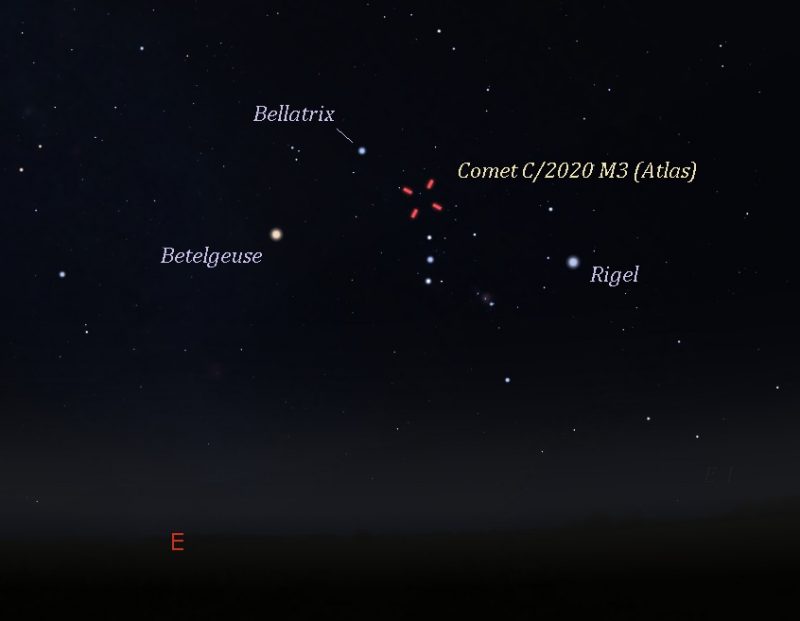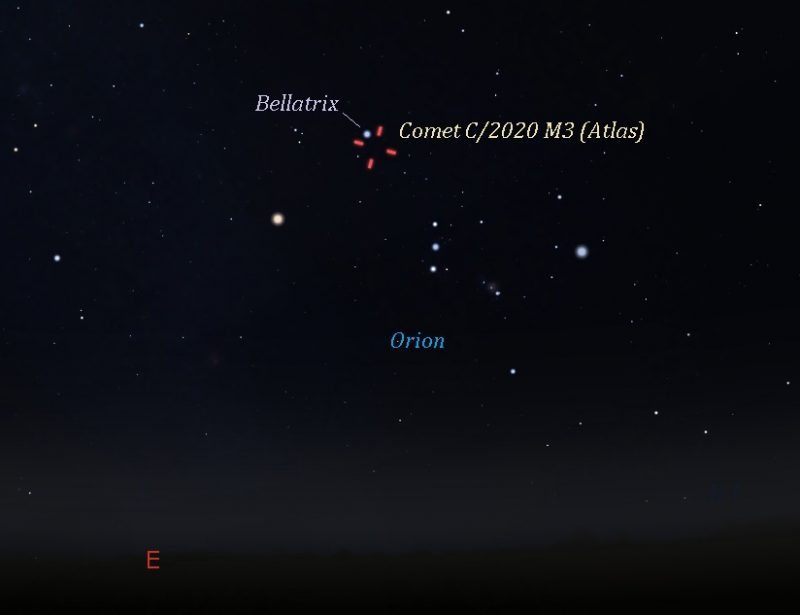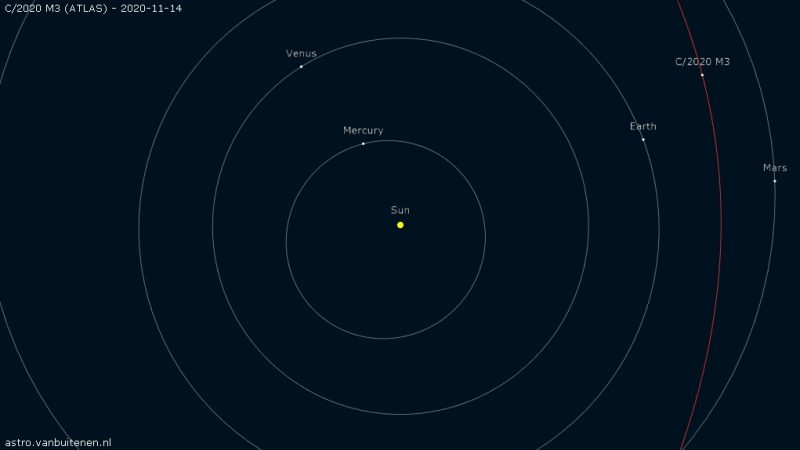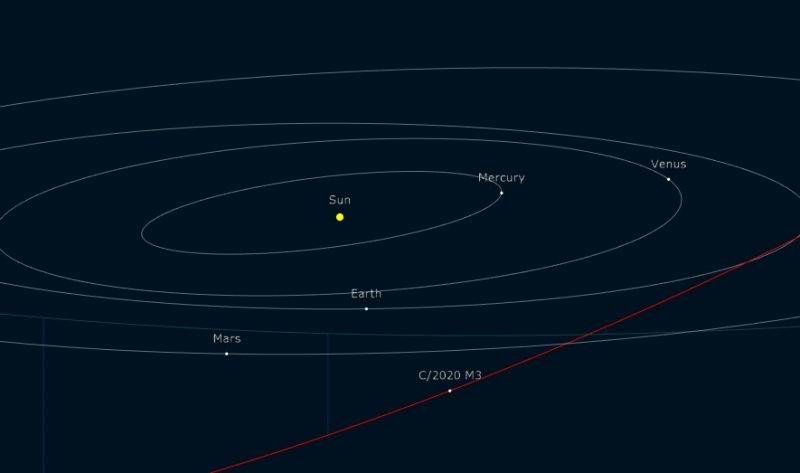

Location of Comet C/2020 M3 (Atlas) on the night of Wednesday, November 11, 2020. This chart faces east around 10 p.m. local time, as seen from the U.S. See how the comet is lined up with the famous Belt of Orion? Those 3 medium-bright stars – in a short, straight row – point right to the comet. Be forewarned: this comet isn’t as bright as NEOWISE was last summer. Be sure to look in a dark sky, with binoculars or a small telescope. Illustration via Eddie Irizarry using Stellarium.
A comet discovered this past summer is currently approaching Earth’s vicinity. Comet C/2020 M3 (Atlas) won’t become bright enough to see with the unaided eye, but binoculars can pick it up. We’ve seen some good images via long-exposure photography, even with just zoom lenses. The ATLAS telescope system – two telescopes being developed by University of Hawaii as an asteroid or comet impact early warning system – was the first to spot Comet C/2020 M3 (Atlas) on June 27, 2020. The comet reached its perihelion, or closest approach to the sun, on October 25. Now the comet is heading for its closest approach to Earth, which will be on Saturday, November 14, 2020.
Comet C/2020 M3 (Atlas) will pass at a very safe 33,313,846 million miles (53,613,439 km) distance, or between the orbits of Mars and Earth.
The first tweet below – from Michael Jaegar (@Komet123Jager on Twitter) on November 7 – provides an exquisite view of Comet C/2020 M3 (Atlas), at right. From our earthly perspective, the comet is passing this week not far from the great Orion Nebula (M42), seen in Jaegar’s first image below at lower left. The Running Man Nebula is also visible on top of the Great Orion Nebula on this long exposure image.
Comet C/2020 M3 (Atlas) near M42 nov. 6 UT 23.30 UT 15x3min 8"/2 RASA Nikon Z50mod, bright moonlight Michael Jäger pic.twitter.com/SBgSRVtci0
— Michael Jäger (@Komet123Jager) November 7, 2020
Hello Comet C/2020 M3 Comet in Orion on November 8th: It was a very clear night. Despite the moonlight, I could see the Milky Way. Halpha RGB 2×600 and 6x450sec Leica Apo-Telyt f-280 / 4.3 QHY 600 2×2 bin. Michael Jäger pic.twitter.com/5MhHXif5Z2
— Michael Jäger (@Komet123Jager) November 8, 2020
Hello Comet C/2020 M3 (Atlas) oct. 15 25×3 mit 12"/4 Z50mod. Michael Jäger pic.twitter.com/eRJSVi1RGR
— Michael Jäger (@Komet123Jager) October 15, 2020
Currently at a visual magnitude between 7.8 and 8.0, Comet C/2020 M3 (Atlas) is visible with binoculars from dark skies. Please note that the views of this comet are in no way as good as those offered by Comet C/2020 F3 (NEOWISE), which provided a grand spectacle this past summer.
Still, it’s a thrill to see the comet! And remember that – every time we have the opportunity to see a new comet – you might take into account that each of these events may be a once-in-a-lifetime experience. That is the case with Comet C/2020 M3 (Atlas). After its closest approach on November 14, this comet will not return to Earth’s vicinity until year 2159.
Lucky for us, Comet C/2020 M3 (Atlas) is easy to locate, as it glides through the well-known constellation of Orion the Hunter.
Using a small telescope or good binoculars (steadily held), the celestial visitor will appear as a fuzzy, small, diffuse object. It does not look like a star. When you view it, it will appear motionless. But note the stars around it, wait 15 minutes, and then return to view … and you might detect it has changed its position, barely, with respect to background stars. All objects in space are moving. But we don’t see the stars move; they are “fixed” because they’re so far away. This comet, on the other hand, is relatively nearby and moving at 32,019 miles per hour (51,529 km/h). Its motion can most easily be detected from one night to the next.
Around its closest approach to Earth on November, comet M3 Atlas should appear to cross a sky distance similar to a full moon diameter in about 6 hours.
Sky enthusiasts can try to capture long-exposure images and review the results. You will be searching for a very small, greenish object. Although it will appear as a tailless and diffuse small sphere, it’s amazing how big a comet’s coma, or extended atmosphere, really gets. The nucleus – or core – of a comet is usually about a mile wide (1 to 2 km), but – as it travels closest to the sun that binds it in orbit – the sun’s heat causes the comet’s gases to puff up, creating a huge sphere of gas around the comet. This is the coma or cometary atmosphere.
Australian Michael Mattiazzo, an experienced comet discoverer and observer, estimates Comet C/2020 M3 (Atlas) has developed a coma about 211,000 miles (340,000 km) in diameter. That’s almost the distance from Earth to the moon, which is about 239,000 miles away!
We hope the charts below will enable you to find and enjoy Comet C/2020 M3 (Atlas)!

This chart faces east around 10 p.m. local time on November 14, 2020, the night of the comet’s closest approach to Earth. That night, Comet C/2020 M3 (Atlas) should be even easier to locate than earlier in the week, as it will be very close to where we see the bright star Bellatrix in Orion. The comet should be visible through binoculars or a small telescope, or using long-exposure photography. Illustration by Eddie Irizarry using Stellarium.

During closest approach this Saturday, November 14, 2020, Comet C/2020 M3 (Atlas) will be located between the orbits of Mars and Earth, as seen in this illustration. Chart via astro.vanbuitenen.nl.

Another perspective of the trajectory of Comet C/2020 M3 (Atlas), passing between the orbits of Mars and Earth during closest approach on Saturday, November 14, 2020. Chart via astro.vanbuitenen.nl.
Bottom line: Comet C/2020 M3 (Atlas) is headed for its closest approach to Earth on Saturday, November 14, 2020. It can’t be seen with the eye, but telescope users are beginning to capture glorious images. Charts for finding the comet here.
from EarthSky https://ift.tt/36FuP5F


Location of Comet C/2020 M3 (Atlas) on the night of Wednesday, November 11, 2020. This chart faces east around 10 p.m. local time, as seen from the U.S. See how the comet is lined up with the famous Belt of Orion? Those 3 medium-bright stars – in a short, straight row – point right to the comet. Be forewarned: this comet isn’t as bright as NEOWISE was last summer. Be sure to look in a dark sky, with binoculars or a small telescope. Illustration via Eddie Irizarry using Stellarium.
A comet discovered this past summer is currently approaching Earth’s vicinity. Comet C/2020 M3 (Atlas) won’t become bright enough to see with the unaided eye, but binoculars can pick it up. We’ve seen some good images via long-exposure photography, even with just zoom lenses. The ATLAS telescope system – two telescopes being developed by University of Hawaii as an asteroid or comet impact early warning system – was the first to spot Comet C/2020 M3 (Atlas) on June 27, 2020. The comet reached its perihelion, or closest approach to the sun, on October 25. Now the comet is heading for its closest approach to Earth, which will be on Saturday, November 14, 2020.
Comet C/2020 M3 (Atlas) will pass at a very safe 33,313,846 million miles (53,613,439 km) distance, or between the orbits of Mars and Earth.
The first tweet below – from Michael Jaegar (@Komet123Jager on Twitter) on November 7 – provides an exquisite view of Comet C/2020 M3 (Atlas), at right. From our earthly perspective, the comet is passing this week not far from the great Orion Nebula (M42), seen in Jaegar’s first image below at lower left. The Running Man Nebula is also visible on top of the Great Orion Nebula on this long exposure image.
Comet C/2020 M3 (Atlas) near M42 nov. 6 UT 23.30 UT 15x3min 8"/2 RASA Nikon Z50mod, bright moonlight Michael Jäger pic.twitter.com/SBgSRVtci0
— Michael Jäger (@Komet123Jager) November 7, 2020
Hello Comet C/2020 M3 Comet in Orion on November 8th: It was a very clear night. Despite the moonlight, I could see the Milky Way. Halpha RGB 2×600 and 6x450sec Leica Apo-Telyt f-280 / 4.3 QHY 600 2×2 bin. Michael Jäger pic.twitter.com/5MhHXif5Z2
— Michael Jäger (@Komet123Jager) November 8, 2020
Hello Comet C/2020 M3 (Atlas) oct. 15 25×3 mit 12"/4 Z50mod. Michael Jäger pic.twitter.com/eRJSVi1RGR
— Michael Jäger (@Komet123Jager) October 15, 2020
Currently at a visual magnitude between 7.8 and 8.0, Comet C/2020 M3 (Atlas) is visible with binoculars from dark skies. Please note that the views of this comet are in no way as good as those offered by Comet C/2020 F3 (NEOWISE), which provided a grand spectacle this past summer.
Still, it’s a thrill to see the comet! And remember that – every time we have the opportunity to see a new comet – you might take into account that each of these events may be a once-in-a-lifetime experience. That is the case with Comet C/2020 M3 (Atlas). After its closest approach on November 14, this comet will not return to Earth’s vicinity until year 2159.
Lucky for us, Comet C/2020 M3 (Atlas) is easy to locate, as it glides through the well-known constellation of Orion the Hunter.
Using a small telescope or good binoculars (steadily held), the celestial visitor will appear as a fuzzy, small, diffuse object. It does not look like a star. When you view it, it will appear motionless. But note the stars around it, wait 15 minutes, and then return to view … and you might detect it has changed its position, barely, with respect to background stars. All objects in space are moving. But we don’t see the stars move; they are “fixed” because they’re so far away. This comet, on the other hand, is relatively nearby and moving at 32,019 miles per hour (51,529 km/h). Its motion can most easily be detected from one night to the next.
Around its closest approach to Earth on November, comet M3 Atlas should appear to cross a sky distance similar to a full moon diameter in about 6 hours.
Sky enthusiasts can try to capture long-exposure images and review the results. You will be searching for a very small, greenish object. Although it will appear as a tailless and diffuse small sphere, it’s amazing how big a comet’s coma, or extended atmosphere, really gets. The nucleus – or core – of a comet is usually about a mile wide (1 to 2 km), but – as it travels closest to the sun that binds it in orbit – the sun’s heat causes the comet’s gases to puff up, creating a huge sphere of gas around the comet. This is the coma or cometary atmosphere.
Australian Michael Mattiazzo, an experienced comet discoverer and observer, estimates Comet C/2020 M3 (Atlas) has developed a coma about 211,000 miles (340,000 km) in diameter. That’s almost the distance from Earth to the moon, which is about 239,000 miles away!
We hope the charts below will enable you to find and enjoy Comet C/2020 M3 (Atlas)!

This chart faces east around 10 p.m. local time on November 14, 2020, the night of the comet’s closest approach to Earth. That night, Comet C/2020 M3 (Atlas) should be even easier to locate than earlier in the week, as it will be very close to where we see the bright star Bellatrix in Orion. The comet should be visible through binoculars or a small telescope, or using long-exposure photography. Illustration by Eddie Irizarry using Stellarium.

During closest approach this Saturday, November 14, 2020, Comet C/2020 M3 (Atlas) will be located between the orbits of Mars and Earth, as seen in this illustration. Chart via astro.vanbuitenen.nl.

Another perspective of the trajectory of Comet C/2020 M3 (Atlas), passing between the orbits of Mars and Earth during closest approach on Saturday, November 14, 2020. Chart via astro.vanbuitenen.nl.
Bottom line: Comet C/2020 M3 (Atlas) is headed for its closest approach to Earth on Saturday, November 14, 2020. It can’t be seen with the eye, but telescope users are beginning to capture glorious images. Charts for finding the comet here.
from EarthSky https://ift.tt/36FuP5F

Aucun commentaire:
Enregistrer un commentaire